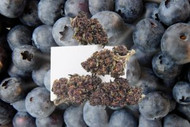Anthocyanins in CBD Flower
Posted by Tweedle Farms on Jun 3rd 2024

Anthocyanins in Cannabis
When you think of CBD flower, you might picture lush green leaves or frosty trichomes glistening in the sun. But did you know that cannabis can also showcase a stunning array of colors, from deep purples to vibrant reds? This visual spectacle is thanks to a group of compounds called anthocyanins. These pigments do more than just make your favorite strains look pretty—they're also powerful antioxidants, responsible for the deep blue hues of nutritional powerhouses like blueberries or acai.
Now, let's dive into the world of anthocyanins and explore why these colorful compounds are making waves in the industry.
What Are Anthocyanins, Anyway?
Anthocyanins are a type of flavonoid, which are natural compounds found in hemp flower, as well as many other plants. They're responsible for the red, purple, and blue colors in fruits, vegetables, and flowers. Think of the rich red of raspberries, the deep purple of eggplants, or the striking blue of blueberries. These pigments are not just for show; they play a crucial role in protecting plants from various stresses like UV radiation, cold temperatures, and even pests.
Interestingly, the color that anthocyanins produce depends on the pH level in the plant cells. In acidic conditions, they appear red. In neutral environments, they turn purple, and in alkaline conditions, they look blue. This versatility makes them fascinating subjects of study, especially when we start looking at their benefits for human health.
Anthocyanins in Cannabis: The Colorful Connection
Cannabis is a diverse plant species with countless varieties, each offering a unique combination of colors, shapes, and chemical profiles. Anthocyanins in cannabis are most noticeable in strains that develop beautiful shades of purple, red, or blue. This colorful transformation is often more pronounced in cooler growing conditions, where the plant ramps up anthocyanin production to protect itself from stress.
For a long time, cannabis research focused primarily on cannabinoids like THC and CBD. But now, there's a growing interest in the plant's other compounds, including terpenes and flavonoids like anthocyanins. So, what makes anthocyanins worth exploring in cannabis?
What Influences Anthocyanin Production in Cannabis?
Several factors can influence how much anthocyanin a cannabis plant produces. These include genetics, environmental conditions, and how the plant is cultivated.
Genetics
Just like people, cannabis plants have genetic traits that make them unique. Some strains are naturally inclined to produce high levels of anthocyanins. If you’re after those stunning purple hues, look for strains known for their colorful genetics.
Environmental Conditions
Temperature and light play significant roles in anthocyanin production. Cooler temperatures, especially during the night, can boost anthocyanin levels. This is why some growers manipulate the temperature to enhance the colors in their crops. Similarly, exposure to UV light can trigger the plant to produce more anthocyanins as a protective measure.
Cultivation Practices
How you grow your cannabis can also impact its anthocyanin levels. Proper nutrient management and maintaining the right pH levels in the soil or growing medium are crucial. Organic growing practices, which avoid synthetic chemicals, often result in more vibrant colors and healthier plants.
The Benefits of Anthocyanins in Cannabis
Anthocyanins aren’t just eye candy—they bring a host of potential benefits for both the plant and those who consume it.
Antioxidant Powerhouse
Anthocyanins are known for their strong antioxidant properties. They help protect cells from damage caused by oxidative stress. In plants, this means better resistance to environmental stresses. For us, consuming antioxidant-rich foods, can help fight off free radicals, potentially lowering the risk of chronic diseases and supporting overall health.
To be clear, there is NO evidence that smoking, eating, or making edibles with purple cannabis will provide any meaningful amount of antioxidants. If fighting free radicals is your goal, eat a handful of blueberries!
Aesthetic Appeal and Market Value
Let’s not forget the visual appeal of anthocyanin-rich cannabis. Strains with striking colors are highly attractive to consumers and can command higher prices in the market. The visual beauty of these strains adds to the overall experience, making them more than just a therapeutic option but also a feast for the eyes.
Looking Ahead: The Future of Anthocyanin Research in Cannabis
We’re just beginning to scratch the surface when it comes to understanding anthocyanins in cannabis. There’s a lot more to learn about their potential benefits and applications. Here are a few areas where future research could make a big impact:
1. Identifying High-Anthocyanin Strains: Cataloging cannabis strains with high anthocyanin content can help breeders and growers develop new varieties that are both beautiful and beneficial.
2. Understanding Production Mechanisms: Studying how and why cannabis plants produce anthocyanins can help optimize growing conditions to maximize these compounds.
3. Exploring Therapeutic Uses: Investigating the combined effects of anthocyanins and cannabinoids could uncover new therapeutic applications, particularly for anti-inflammatory, neuroprotective, and cardiovascular health.
4. Educating Consumers: As more people learn about the benefits of anthocyanin-rich cannabis strains, they can make more informed choices and appreciate the full value of these unique plants.
Wrapping Up
As the cannabis industry continues to evolve, the role of anthocyanins will likely become more significant. Whether you’re a grower looking to cultivate eye-catching strains or a consumer interested in the health benefits of your favorite plant, anthocyanins are definitely worth paying attention to. So next time you see a beautiful purple bud, or smoke a pre roll made from a purple strain, you’ll know there’s more to it than meets the eye—there’s a world of science and potential health benefits packed into that colorful package.



